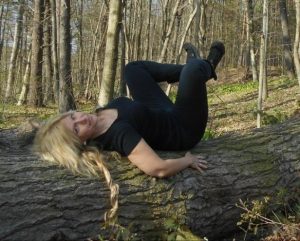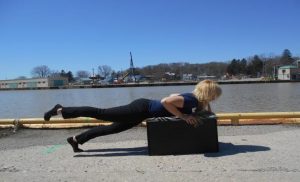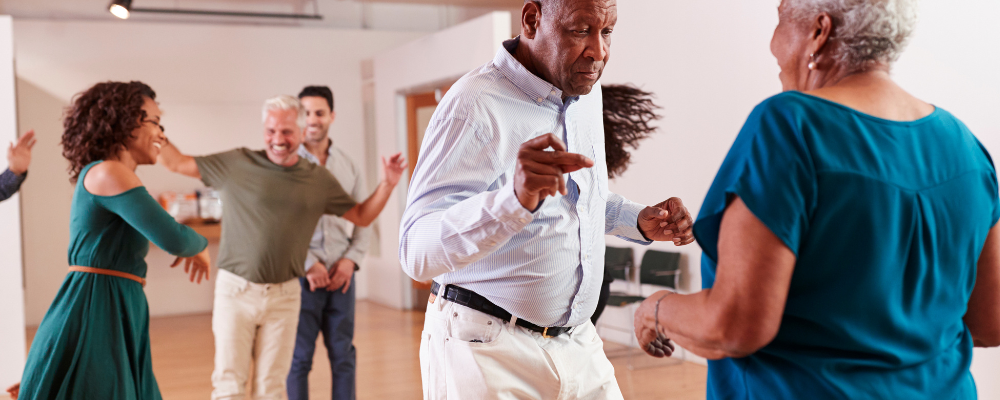The hip is a ball and socket joint. It provides stability and balance as well as the ability
to move your legs during everyday activities. It is a fairly stable joint and usually offers
a good range of motion. Many older adults, however, have felt the deep dull ache in
their hips at the end of the day. What causes that feeling? Gravity is the culprit.
Gravity “squishes” your joints which has the result of reducing their protective synovial
fluid. In particular, the hip joint is compressed or “squished” by all the weight of the
body above it. Compression is like squeezing a sponge. It squeezes synovial fluid from
the space in the joint, decreasing its lubrication. Synovial fluid reduces friction acting
like WD40 for your joints and providing lubrication and ease of movement.
It was once believed that physical activity was injurious to the joints. Recent research,
however, has shown that movement can actually decrease the risk of osteoarthritis.
When we are walking or moving around, blood is pushed back up to the heart through
muscle contractions. Muscles work like little pumps moving blood around the body.
However, if the muscles are contracted or immobile for a long period of time, such as
when you are standing or sitting at length, they cannot produce a muscle pump effect
and thus hinder circulation and lubrication of the joints.
Standing for a prolonged period also overworks postural muscles, many of which are
located around the hip area. Postural muscles are important as they keep your body
from falling over but when they are overworked, they become exhausted, resulting in
tightness and pain.
The most common cause of chronic hip pain is arthritis. Arthritis is often felt in the
front of your thigh or in the groin. Hip pain can also be the result of a sudden injury
such as during a slip or fall incident or a gradual onset injury such as with jobs that
involve a common repetitive workplace activity. In most cases, hip pain will improve
with exercise. Here are a few to get you started.
Crouching: If we think of primitive man, squatting has been the typical position to
cook, eat, relax, or go to the bathroom. Squatting is a natural movement. If you watch
small children, you will see they lower themselves to the ground with ease. It’s a
modern concept to sit in chairs with the hips at ninety degrees. It is not until the deep
part of the squat that your hip is properly lubricated. To perform a resting squat, make
certain your feet stay flat on the floor as you lower your hips towards the ground. If
we lift our heels to crouch our knees get overloaded. Make it a daily habit to squat
down and hang out in this position if your knees allow. If you have painful knees
skip to the next exercise.

The Frog: If you can’t get into a crouching position because of painful knees, the Frog
is a great alternative. The Frog is a good exercise to assist with hip and knee joint
mobility by strengthening the supporting muscles around the hip. Be certain to anchor
your tailbone to the floor as you draw your knees in towards your chest. Next, keep
your bottom ribs anchored to the floor as you lengthen your legs away from your body.
Make certain to press your heels together as you extend your legs. When you reach full
extension, zip up your inner thighs by imagining you are holding a piece of paper
between your knees. Return to the starting position. Repeat 10x

Prone Hip Extension: We use hip extension a lot in daily life to stabilize the pelvis
and propel us forward in activities like walking, standing up, and climbing stairs. This
motion is one of the first areas to lose mobility as we age. That is one of the reasons
that many older adults shuffle when they walk. Start this exercise with your upper
body fully supported lying on a bed or a secure table. Anchor your hips firmly as you
squeeze your bottom and lift one leg eight to ten times. Repeat on the other side.

Figure Four Stretch: This is one of my all-time favorite stretches because it
stretches the hip and can provide relief from back pain and sciatica as well. Not only is
it a great stretch, but the same type of movement can also be used to increase hip
strength and improve mobility when it is done in a more dynamic way. Many older
adults don’t have the strength and flexibility to cross their legs comfortably. One of the
exercises that helps to increase strength in the hip and flexibility is the Figure Four.
Start out sitting in a chair then make the movement of crossing your legs like you are
trying to tie your shoes. If you can’t get your foot over your knee just tap the foot to the
inside of the leg. This is a basic movement we use in our everyday life (think socks and
shoes and cutting your toenails). If you are able to bring your foot over your opposite
knee, hold the position and enjoy the stretch. To continue this stretch, keep your spine
straight as you press your tailbone towards the back of the chair and lean forward at
the hips bringing your sternum towards your knee.
The general rule with stretching is to hold the stretch in a comfortable position for 30
seconds. If you know you have high blood pressure only hold for a count of five.
Counting out loud is the best way to make certain you are not holding your breath.
Remember if you have a hip replacement make certain never to cross your legs or lift
your knees past ninety degrees. Always check with your physician before starting an
exercise program.
Try to incorporate these simple exercises into your daily routine. Hip, Hip hooray you
are on the way to stronger more flexible hips today!






